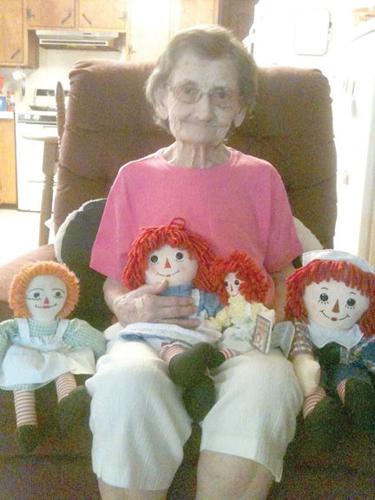Raggedy Ann Stitched Back Together Again

Gladys Cooper sits with her favorite Raggedy Ann and Raggedy Andy dolls.
BY JENNIFER BOYD
FOR THE LORIS SCENE Jboyd73@outlook.com
The beloved Raggedy Ann doll has been woven into our childhoods and hearts for almost 100 years, and this iconic doll has been seen in print, cartoons, movies, and books all over the world. Although there were myths and controversies surrounding this American treasure, she withal remains an important part of our civilization to this very mean solar day.
The creator
John Barton Gruelle, better known as Johnny, was built-in in 1880 in Arcola, Ill. His father, R.B. Gruelle, was a member of the famous Hoosier Impressionists movement. At an early age, his father gifted Johnny with the love of drawing and the art of storytelling.
Although he admired the beauty of his begetter's landscape paintings, he felt his talent was in cartooning. In 1901, he landed his outset paying job at The People, a tabloid gossip newspaper in Indianapolis.
He fine-tuned his "chalk-plate" portraits, and in Apr 1902, he moved to the accredited Indianapolis Sun. While working at the paper, he moonlighted at the Detroit Peninsular Engraving Company.
In 1908, he won a national comic cartoon contest, which lead to a job at the prestigious New York Herald. His "Mr. Twee Deedle" Sunday cartoon became a huge hit among all ages, which secured commissions from several monthly and weekly publications. "McCall's," "The Ladies' Earth," and "Physical Culture" were amidst the publications that opened their pages to his work.
A doll is born
While he and his immature wife, Myrtle, were visiting his parents, he took a intermission from drawing to plunder for inspiration in the family'south attic. Information technology was there he came across an former doll his mother had stitched together for his sister, who already had a family unit of her own. He gave the raggedy doll to his immature daughter, Marcella, who asked her grandmother to stitch a face upon the bare canvas.
The Raggedy Ann doll was born. She lovingly gave the doll a triangle nose, brown hair, and button eyes. The old doll was immediately adopted into their family unit and became a best friend to his precious daughter.
He began drawing Raggedy Ann with a storyline, and in 1915, a patent and trademark was granted to market the doll. He watched Marcella play with her doll for hours, which became the inspiration for "The Tales of Raggedy Ann."
Seeing the love his girl had for the doll warmed his soul. Unfortunately, the 2 playmates would soon be separated by expiry, and a father would lose his muse.
Saying 'goodbye'
The Gruelle family became outspoken adversaries of vaccine apply in public schools. At the time, children and parents had no selection but to accept the serial of shots, given to them during schoolhouse hours, to prevent the modest pox illness. Gruelle's association with "Concrete Culture" Magazine gave him the platform necessary to vox his stance of vaccination, which was stern and unapologetic, to say the least.
Soon later on his girl's 13th altogether, she was given the series of vaccines in school. She became ill from the shots that proved to be fatal. Alan R Yurko, CPPCC, Sc. of the Idaho Observer said, "Marcella's expiry was non an immediate reaction. She died a very dull and subtle death. In the months after her unconsented inoculation, she became lethargic and lost her appetite. Marcella became feverish, fatigued and hypotonic [loss of musculus control] as her body and nervous organization fought hard against the poisons forced into her bloodstream. At the end, she was equally limp every bit a ragdoll."
Her decease sparked an outrage within the family unit and community. Gruelle was asked to comment on his feelings regarding her death in "Concrete Culture" Magazine and he drew his famous cartoon of a monster holding a scale.
Under the satire, Gruelle printed, "Having recently lost our merely daughter through vaccination (in public school, without our consent), you may realize how terribly HUMOROUS the subject of vaccination appears to Mrs. Gruelle and myself. Of the vii physicians called in on the instance, six pronounced it in emphatic terms MALPRACICE. The 7th did not commit himself, existence the head of the school board and a firm advocate of vaccination."
Moving forward
In 1922, Gruella honored his girl by marketing the doll with Marshall Field, and publishing "Raggedy Ann Stories" with P.F. Volland Visitor. Although her hair inverse to a vivid red, the doll kept its charm and whimsical design. He eventually added a brother to her story, named Raggedy Andy, which became a beloved storyline. He defended his life to making others smile.
He continued sketching for newspapers and magazines, including "Good Housekeeping," "Cosmopolitan," "Life," and "College Humor" until his death in 1938. His characters, dolls, books, and comic strips volition continue to be cherished all over the world. Although he and his family unit experienced the horrific expiry of their girl, they turned the loss into a teachable moment in history.
Today, many people collect the Raggedy Ann doll. The logo has been placed on everything from plates to high chairs. Some of the early dolls take sold for more than than $three,000, making information technology a highly sought-after antiquarian.
Many parents are again questioning the use of vaccines and whether they impairment or help children. Although Johnny Gruelle did not create the loving doll to exist the poster kid for not-vaccination, it volition indelibly exist remembered as being affiliated with the move. He, on the other paw, will forever be known every bit "The Raggedy Ann Man."
Source: https://www.myhorrynews.com/news/local/loris/looking-back-the-untold-story-of-raggedy-ann/article_57036736-5310-11e4-9a53-0017a43b2370.html
0 Response to "Raggedy Ann Stitched Back Together Again"
Post a Comment